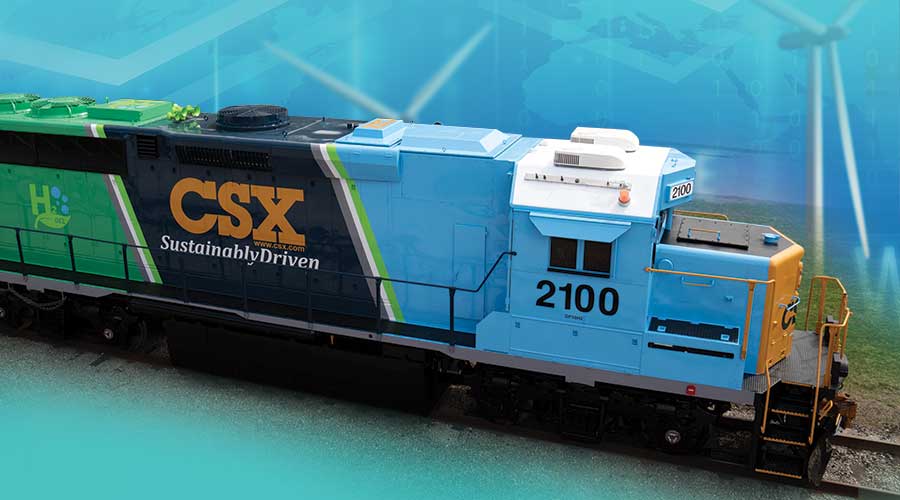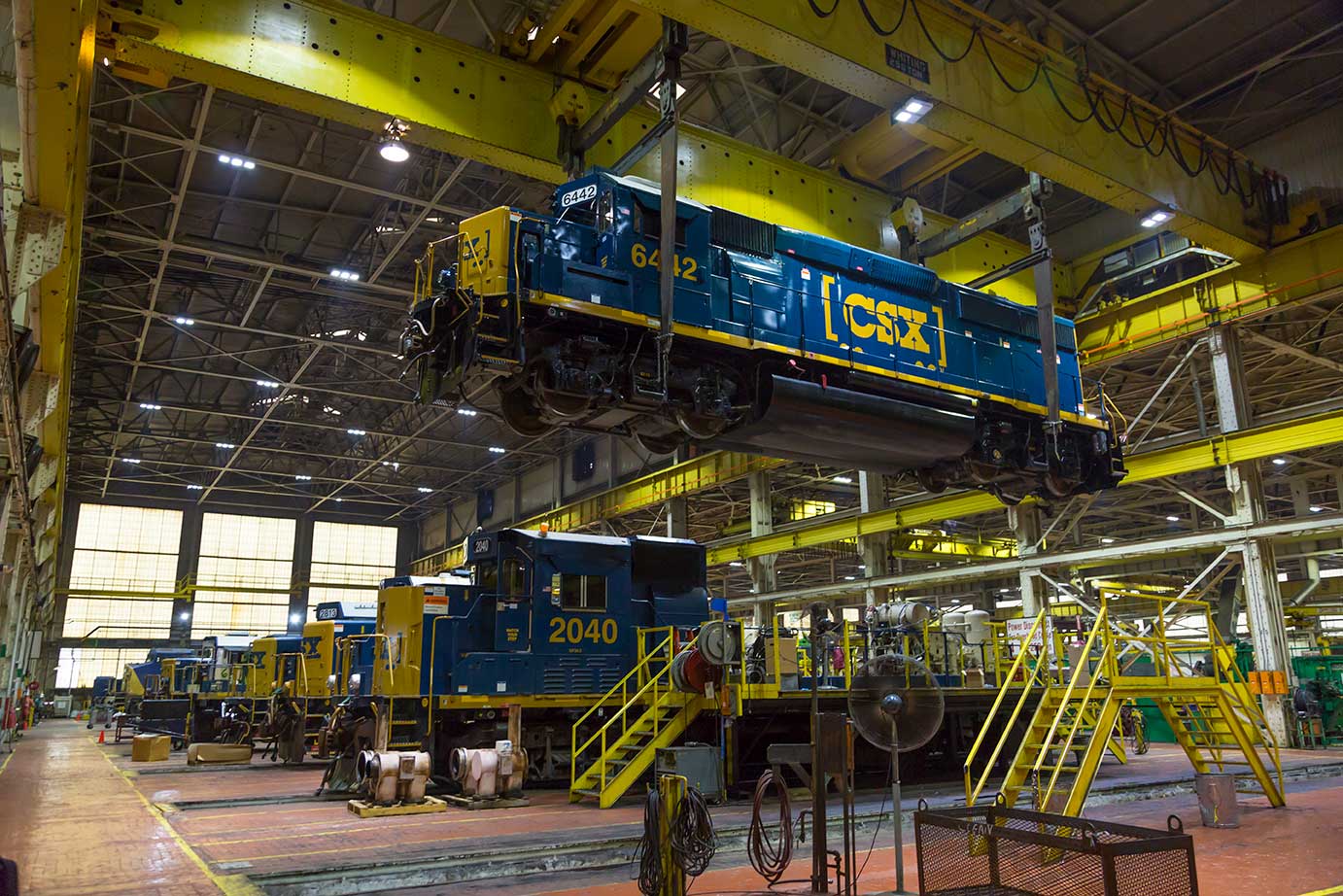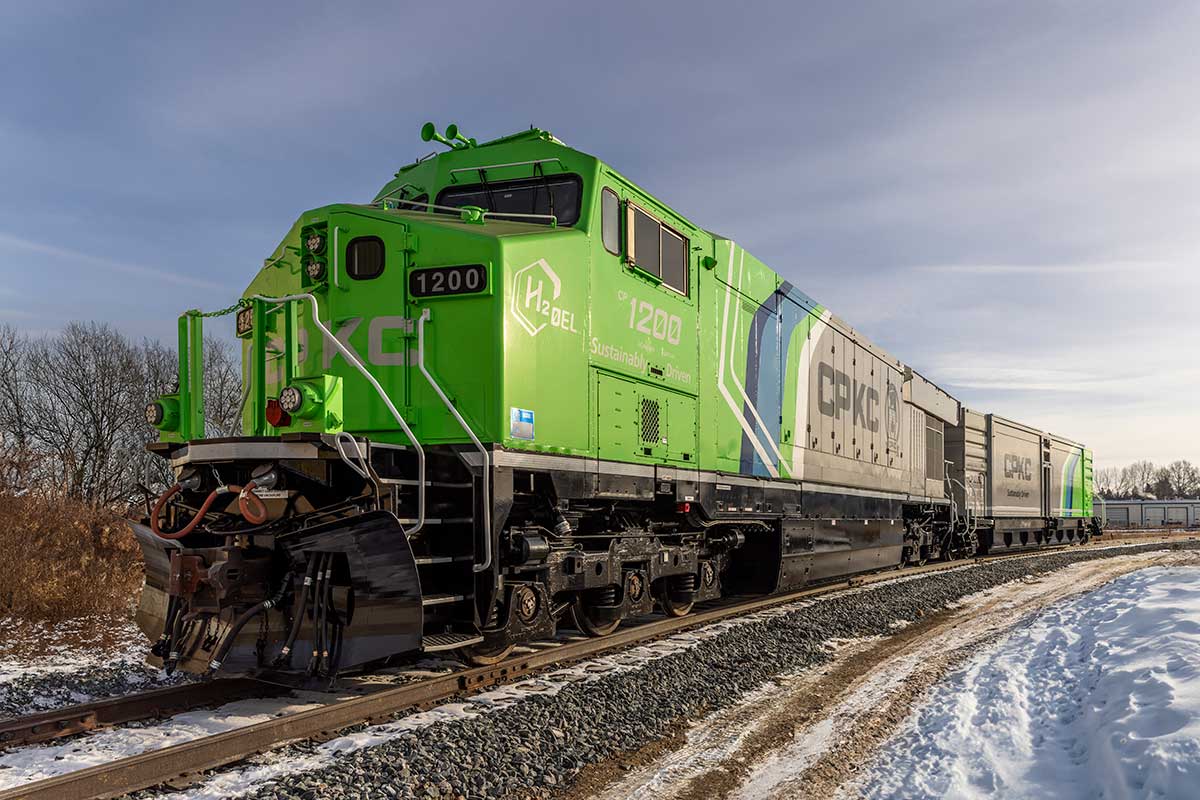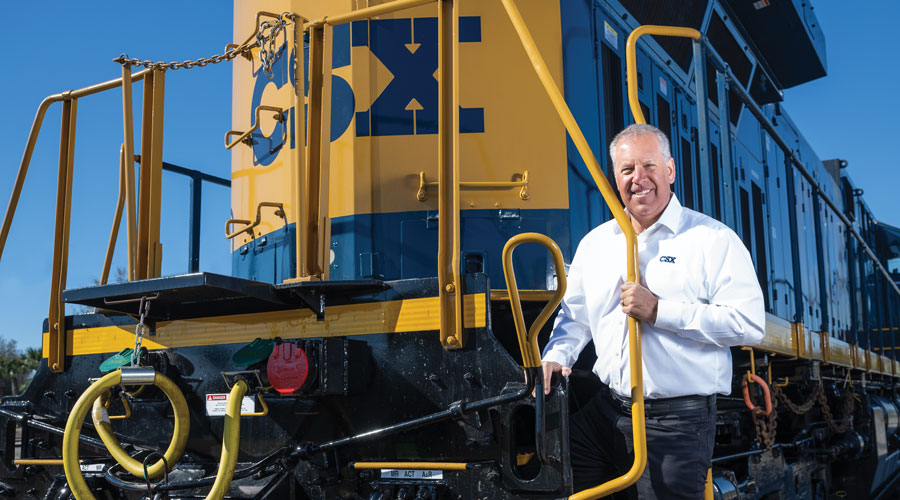Stay updated on news, articles and information for the rail industry
June 2024
Rail News: CSX Transportation
Hydrogen locomotives could help fuel CSX's emission-reduction journey

By Jeff Stagl, Managing Editor
A watershed moment in Class Is’ sustainability pursuit is less than six years away. Each of the six large roads plans to greatly reduce greenhouse-gas (GHG) emissions by 2030.
For CSX, the target to hit by then is a 37.3% decrease in GHG emission intensity, as measured against a 2014 baseline year.
Reaching that objective will require the embrace of emerging technologies and the adoption of promising alternative fuels, CSX leaders say. But achieving a much more ambitious air quality goal by 2050 — when many Class Is expect to reach zero emissions — will mandate the elimination of diesel-powered equipment.
CSX leaders are keenly aware that innovations and operating practice changes are the critical gears in the Class I’s emission-reduction drive, and that a locomotive that can operate on an eco-friendly fuel source will be the primary propellant. Diesel used to fuel locomotives and other equipment currently accounts for more than 70% of CSX’s GHG emissions.
To meet long-range sustainability goals, the railroad needs a zero-emission locomotive, says Corey Davis, CSX’s director of innovation-alternative fuels and energy management.
CSX currently operates more than 3,000 locomotives and constantly adjusts its active motive-power fleet based on demand and other factors.
The Class I is seeking to deploy locomotives that don’t emit nitrogen oxides, particulate matter and other pollutants to comply with more stringent sustainability demands from shippers, shareholders, communities and other stakeholders.
Whether that turns out to be motive power that runs on hydrogen, batteries or some other green fuel source remains to be seen. No matter the ultimate choice or choices, the transition to zero-emission locomotives is inevitable, Davis stresses.
“This is the fleet of the future,” he says. “All signs point to heading this way over the years.”
CSX got a head start on a potential future fleet in April, when it unveiled a prototype of its first hydrogen locomotive. The Class I developed the unit through a partnership it forged with Canadian Pacific Kansas City last year.
It will be the first production hydrogen-powered locomotive to be used by a U.S. railroad, says Davis.
Hydrogen presents a promising alternative to fossil fuels — such as diesel — offering greater efficiency and zero emissions, CSX leaders say.
Hydrogen locomotives emit only water vapor. Hydrogen fuel cells generate the electricity that powers the locomotive.
The prototype features a hydrogen conversion kit developed by CPKC. In January 2023, a CSX team traveled to Calgary, Alberta, to visit with a CPKC team to discuss the development of hydrogen locomotives.
CPKC — which has worked on designing such a locomotive for several years — is much farther along the development curve, Davis says.
“This meeting came at the right time for us. CPKC has a couple of years head start, which gives us an edge,” he says. “We liked what we saw and heard, and we figured we can do it, too. We realized this can be the next generation of locomotives.”
The meeting prompted CSX to enter into a partnership with CPKC in summer 2023.
Less than 12 months later, CSX developed its own hydrogen locomotive featuring the CPKC kit, says Davis.
Hunting for results in Huntington
Workers at CSX’s locomotive shop in Huntington, West Virginia, converted a four-axle GP38 locomotive into the hydrogen prototype. The idea was to use as much of the existing locomotive as possible, stripping it down to the frame and reusing the cab, traction motors and trucks, says CSX Director of Locomotive Engineering Dragan Jankovic.
That effort further extended the locomotive’s useful life. The GP38 is the first locomotive that’s been 100% remanufactured for hydrogen, says Jankovic.
CSX plans to continue to develop the hydrogen-powered product line to create the most efficient locomotive possible, he says.

“We are looking for a locomotive we can repeat in a manufacturing setting,” says Jankovic.
For now, the prototype will be field tested at the Huntington shop to evaluate its performance and operational feasibility. The 4,000-horsepower-equivalent switcher unit is tailored for yard or local service uses. CSX’s locomotive fleet includes more than 200 switchers.
Tests will be performed at the shop’s test track, on which the locomotive can reach a speed up to 30 mph. If any reengineering, small adjustments or tweaks are needed on the prototype, they can be performed at the heavy rebuild/repair shop.
Tests will continue into the third quarter, and then the locomotive will be used at the Huntington yard, says Jankovic.
The 11.5-acre shop has more than 260 employees, with about 20 assigned to the hydrogen locomotive project.
“The shop has been around a long time. They built steam engines there at one time,” says Jankovic.
Since a variety of workers are employed at the facility — including electricians, boilermakers and pipefitters — their expertise is factoring highly into the project.
“There is no team like it,” says Davis.
Two additional hydrogen locomotives are under construction at the shop. However, no decision has been made about how many hydrogen units CSX will develop, says Davis. It will depend on hydrogen availability and how the hydrogen supply market is evolving, he adds.
Currently, hydrogen is trucked to the Huntington shop, where a temporary fueling site was established. The future expense and feasibility of creating hydrogen infrastructure throughout the network is a factor that requires consideration, says Davis.
“We have to look at the all-in cost of hydrogen,” he says.
Batteries included?
CSX also needs to consider using locomotives that are powered by other sources, such as batteries. To that end, the Class I has been working with the Maryland Department of Transportation (MDOT) on the purchase of three battery-powered locomotives from Wabtec Corp. The units would operate at CSX’s Curtis Bay Terminal at the Port of Baltimore — marking the first use of zero-emission locomotives at an East Coast port.
After conducting a pilot project to test the battery technology, CSX committed to funding the three battery-powered units plus future maintenance costs, plus a portion of the purchase price to install charging facilities.
In September 2023, the Class I learned MDOT won a $11.6 million Consolidated Rail Infrastructure and Safety Improvement grant from the U.S. Department of Transportation to replace three older diesel-electric switching locomotives with three new battery-electric locomotives and one battery charger at the Baltimore port. CSX will provide a funding match to the federal grant.
While pondering a wider use of hydrogen and/or battery locomotives, one thing to keep in mind are “deserts,” or areas where the availability of those fuel sources is low, says Davis.
Meanwhile, there’s another locomotive power source that CSX is weighing as a potential sustainability booster: biodiesel. A renewable and biodegradable fuel, biodiesel is manufactured from vegetable oils, animal fats or recycled restaurant grease.
In 2022, CSX began testing and evaluating a 20% soybean oil-based fuel — a B20 biodiesel blend — in a locomotive fleet serving Mosaic, a Tampa phosphate customer.
The railroad worked with Wabtec to demonstrate the effectiveness of the B20 biodiesel blend in Wabtec FDL Advantage engines in 10 locomotives. CSX has submitted test data to the U.S. Environmental Protection Agency to gain federal approval for a long-term use of higher biodiesel fuel blends in locomotives.
A cruise control of sorts
Also in 2022, CSX began a project aimed at reducing fuel usage in the near term. The Class I partnered with Wabtec to become the first railroad to test the supplier’s Trip Optimizer Zero-to-Zero technology. CSX since has been working with the Federal Railroad Administration to test and implement the technology.
Trip Optimizer is designed to automatically control locomotive throttle and brakes to lower fuel burn based on such dynamics as terrain and speed restrictions.
The railroad implemented Trip Optimizer a number of years ago, and Zero-to-Zero further expands its benefits, CSX officials say.
Zero-to-Zero enables a train to start from zero mph and stop automatically using intelligent controls, according to Wabtec. It leverages air-brake control and signal-aspect information, helping to further expand the opportunity for fuel savings and improved operations.
CSX also is analyzing the advantages of revised automatic engine start/stop (AESS) systems. Software and hardware changes on an AESS system are being evaluated with Wabtec on six locomotives.

“It looks promising,” says Jankovic, adding that locomotives equipped with the revised AESS system sit longer without their engine running.
In addition, CSX is trying to make air compressor changes — perhaps by employing two smaller air compressors — to help make locomotives more efficient.
Another sustainability boost on motive power could come from electric horns, which use less energy than compressed-air horns. Today’s horns use a lot of compressed air, says Jankovic.
“I’d like to see the industry go to electric horns,” he says.
Finding more ways to innovate is all about stepping deeper into the inventor space, Davis believes.
“It’s about using the brainpower of employees to help invent,” he says.
CPKC: High on hydrogen
While CSX marks advances with its hydrogen locomotive and motive-power improvement projects, its partner CPKC is making strides with its own hydrogen locomotive.
In December 2020, Canadian Pacific first announced plans to develop North America’s first line-haul hydrogen locomotive by retrofitting a diesel locomotive with hydrogen fuel cells and battery technology to drive the electric traction motors.
A prototype — which was designed and built by CP engineers — marked its first movement in late 2021. By the end of 2022, it made its first revenue-service moves.
CPKC since has deployed a second hydrogen-powered locomotive. Now, two low-horsepower hydrogen locomotives are serving CPKC customers every day in Calgary.
“We have to look at the all-in cost of hydrogen.”
— Corey Davis, CSX
In addition, the Class I has fabricated its first high-horsepower hydrogen locomotive, which is undergoing tests. CPKC plans to place the unit in service later this year with a tender car to cycle coal between British Colombia mines and the province’s tidewater area in partnership with Teck Resources Ltd., the Class I’s largest coal customer.
Last year, CPKC and metallurgical coal producer Teck Resources entered into a multiyear contract that includes a first-of-its-kind pilot program that calls for employing the railroad’s hydrogen fuel-cell locomotives in coal-train service.
The tests call for the locomotive to move through the Canadian Rockies and encounter every environmental condition, including rain, cold and snow. CPKC officials characterize that environment as a very challenging and credible freight-movement test bed.
Advancing collaboration with CPKC will help further cement CSX’s commitment to sustainability, the company’s leaders say.
“We are proud to work with CPKC to scale ... hydrogen technology and help pave the way for meaningful sustainable solutions for the future,” said CSX President and CEO Joseph Hinrichs in a press release.
Email questions or comments to jeff.stagl@tradepress.com.


 2025 MOW Spending Report: Passenger-rail programs
2025 MOW Spending Report: Passenger-rail programs
 Gardner steps down as Amtrak CEO
Gardner steps down as Amtrak CEO
 Guest comment: Oliver Wyman’s David Hunt
Guest comment: Oliver Wyman’s David Hunt
 Women of Influence in Rail eBook
Women of Influence in Rail eBook
 railPrime
railPrime





